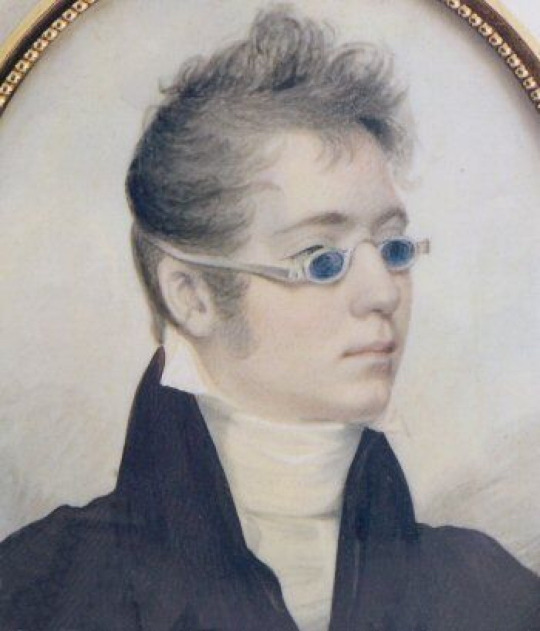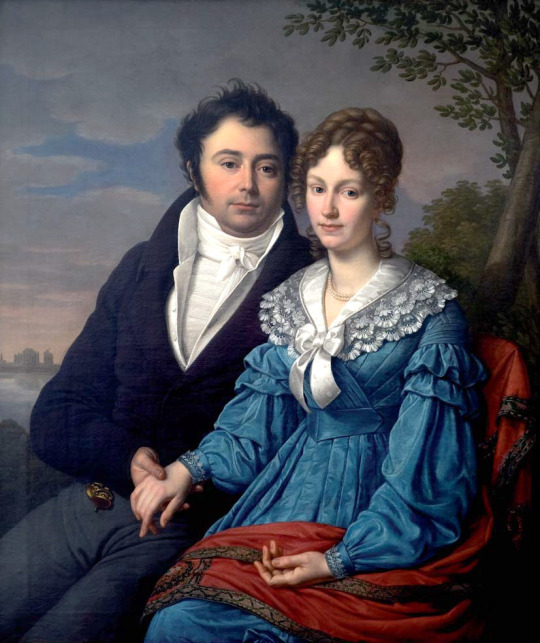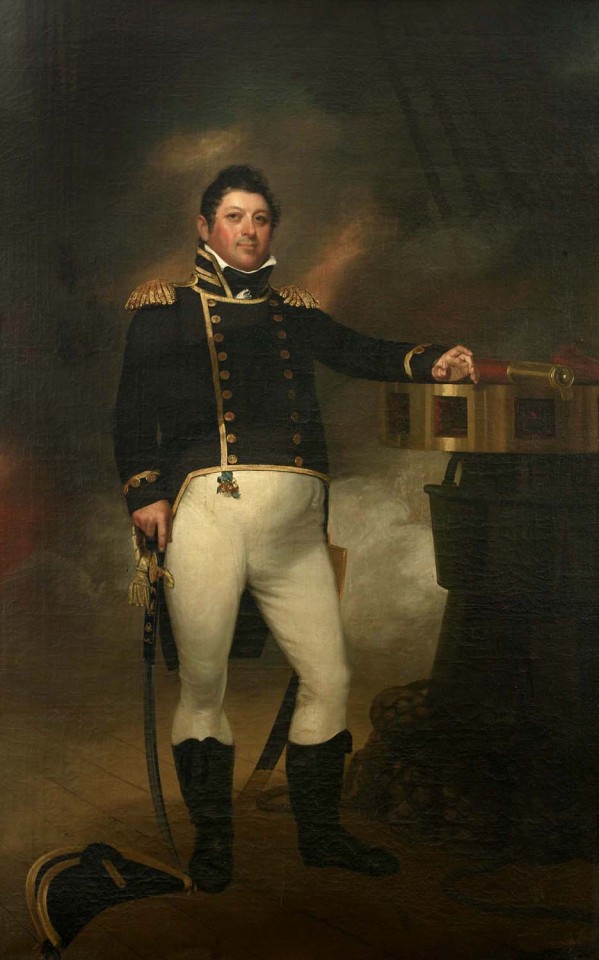#John Wesley Jarvis
Text



random history trivia you should know: in the early 1800s people wore these hipster-style glasses. the first pair is indeed blue; lord byron was also fond of blue sunglasses. green on the right was another popular shade as it was thought cooler colors protected sight better from the yellowish warmth of light. i don't know if that's medically true, but i had a beloved pair of purple glasses once and i thought they were much more comfortable than regular black shades. i'm pretty sure the famous composer franz schubert in the middle there is just wearing regular eyeglasses.
Sources: John Wesley Jarvis' Portrait Of A Gentleman, 1807, composer Franz Schubert at age 17, 1814, Nathaniel Olds by Jeptha Homer Wade, 1839.
#regency era#19th century#1800s#19c#glasses#cool#old school cool#portraits#franz schubert#classical musicians#romantic era#john wesley jarvis#paintings#painting#vintage#history#historical#fashion#style
265 notes
·
View notes
Text

Portrait of Captain Samuel Chester Reid by John Wesley Jarvis, 1815.
An American privateer during the War of 1812, Reid was captain of the General Armstrong at the Battle of Fayal.
#war of 1812#age of sail#military history#samuel chester reid#john wesley jarvis#maritime history#privateer#dressed to kill#1810s#source is beautifully high res
41 notes
·
View notes
Text
Regency Fashion: Veils
Regency era portraits and fashion plates show many examples of how sheer veils, sometimes of lace, were worn as fashionable accessories. For mourning, Regency and Victorian women wore black semi-opaque scarves. And, of course, veils were and continue to be fashionable as bridal wear.
Here are some of my favorite examples of veils in portrait paintings of the Neoclassical/Regency era:

Gilbert Stuart (American, 1755-1828) • Lucinda Smith • 1809
Solely a beautiful lacework veil arranged atop the head, framing the curls on the forehead. No other head accessory here or in the portraits below.



Thomas Lawrence (British, 1769-1830) • Lady Manners • 1794 • Cleveland Museum of Art, Cleveland, Ohio
In the Lawrence portrait, the veil (or perhaps less of a veil and more of a long scrarf) appears to be worn wrapped around the head, leaving some space for curls to show through, and flowing down gracefully past the waist.


Right: John Wesley Jarvis (British, 1780-1839) • Anne Brown Dickey • c. 1807-10
(Veil pinned to the the head with a lovely, pearl-studded comb.)
Left: Elizabeth Vigée Le Brun (French, 1755-1842) • Luise von Mecklenburg-Strelitz, Queen of Prussia • 1802
(A lace-edged scarf of the same material as the dress sleeves is worn with a bandeau and wrapped around a bundle of curls, flowing down the back. There's enough length that the woman can wrap a section of fabric around her lower arm.)
Below are fashion plate examples of hat veils.


These veils are likely worn to shield the face from damaging sun and/or to allow the wearer a certain amount of privacy, especially to hide crying eyes due a death or broken love affair.
#art#portrait#portrait painting#society portrait#fashion & art history blog#elizabeth vigée le brun#fashion history#veils in regency fashion#portraitist#regency fashion#thomas lawrence#john wesley jarvis#the resplendent outfit blog#late 18th-early 19th century art#gilbert stuart#british artist#american artist#french artist#female portrait#regency hat veils#neoclassical fashion history
28 notes
·
View notes
Text

john wesley jarvis. andries stoffles, 1800s.
6 notes
·
View notes
Text

Portrait of Captain Samuel Chester Reid, 1815
John Wesley Jarvis
Oil on canvas
Minneapolis Institute of Art
13 notes
·
View notes
Photo







It’s the later 1810s (from top to bottom) -
ca. 1815 Apolonia Kamińska née Sokołowska by Józef Reichan (location ?). From tumblr.com/lenkaastrelenkaa/701357046637936640 2048X2735 @72 1.5Mj.
1817 Lady by Jérôme-Martin Langlois (private collection). From tumblr.com/historical-fashion-devotee 1280X1597 @72 401kj.
ca. 1817 Heinrich Theodor Wilhelm and Catharina Jakobina Zanders by Heinrich Christoph Kolbe (private collection). From tumblr.com/fashion-history-germany 827X984 @72 268kj.
1819 Anna Pavlovna, Queen Consort of the Netherlands by Alexandre De Latour (Netherlands Royal Collection). From tumblr.com-historical-fashion-devotee; fixed spots w Pshop 1901X2339 @150 881kj.
1819 Sarah Maria Goodrich Giraud by John Wesley Jarvis (David Owsley Museum of Art - Muncie, Indiana, USA). From tumblr.com/historical-fashion-devotee; fixed spots & a few cracks w Pshop 2011X2241 @72 1.3Mj.
1817 Josefa Doubkova and her son Edward by Antonín Machek (National Gallery, Prague). From tumblr.com/historical-fashion-devotee; fixed spots & ridges w Pshop & enlarged to screen 1069X1400 @72 375kj.
Alexandra Buturlina by Nicolas de Courteille (location ?). From tinterest.com/joellefilori/tableaux-groupes/; blurred darker parts of bckgnd to fix spoys w Pshop 1430X1920 @96 639kj.
#1810s fashion#French restoration fashion#late Georgian fashion#Apolonia Kamińska#Józef Reichan#curly hair#square décolletage#long full sheer over-sleeves#waist band#Empire waistline#close skirt#Jérôme-Martin Langlois#tiara#neckline ruff#neckline bertha#mameluke sleeves#Catharina Jakobina Zanders#Heinrich Christoph Kolbe#high neckline#lapels#lace collar#pleated bertha#V waistline#Queen Anna Pavlovna#wrap#Sarah Maria Goodrich Giraud#John Wesley Jarvis#Josefa Doubkova#feathered hat#fur-trimmed coat
9 notes
·
View notes
Text
Portrait of Solomon Isaacs, 1813

John Wesley Jarvis (American, 1780/81-1839)

Portrait of Solomon Isaacs, ca. 1813
Oll on canvas
The Jewish Museum, gift of Mr. and Mrs. Jaeob B. Shulman and J. E. and 2, B.
Butler Foundation, by exchange; estate of Gabriel and Rose Kate Fund; and gift of Kallia H. Bokser, by exchange, 1996-8
Solomon Isaacs (1786-1855) was the son of Justina Brandly Lazarus and Joshua Isaacs;
Joshua was the president of New York's Jewish community
In 1790. Solomon was apprenticed to a copper manufactory (the first in the United States) owned by his brother-in-law Harmon Hendricks, Isaacs's abllity in Industry gained him the nickname "Steamboat," referring to the metal boilers of ships.
He was an active member of Shearith Israel and ultimately became president (parnas) of the congregation.
The three-quarter view and clothing in this portrait indicate that the sitter is well-to-do.
The elegant furniture, carved and gilded with the lion of Judah, underscores the sense of his energy and confidence.
John Wesley Jarvis, the artist, was one of the most admired portraitists of the time and had important ties with New York's business and cultural elites.

0 notes
Text

John Wesley Jarvis, Thomas Paine, c. 1806–07; in the National Gallery of Art, Washington,
0 notes
Photo

John Wesley Jarvis - Black Hawk and His Son Whirling Thunder, 1833 / https://bit.ly/3x8wux6
23 notes
·
View notes
Text
Somehow I missed the part where New York City specifically commissioned the artist John Wesley Jarvis to paint Napoleonic Sexyman portraits of assorted War of 1812 military leaders??
The portraits are even noted by War of 1812 vet Captain Frederick Marryat in his late 1830s travelogue Diary in America:
In the large room of [New York City Hall] are some interesting pictures and busts of the presidents, mayors of the city, and naval and military officers, who have received the thanks of Congress and the freedom of the city. Some are very fair specimens of art: the most spirited is that of Commodore Perry, leaving his sinking vessel, in the combat on the Lakes, to hoist his flag on board of another ship.
This is the portrait of Perry by Jarvis, and it is indeed one of his best representations:

What really sent me down the rabbit hole was a sexyman portrait of Jacob Jennings Brown of all people: previously featured on this blog with a not-so-flattering portrait by the same artist.

Damme! The rest of the collection is equally impressive. I had no idea Captain Isaac Hull of USS Constitution was so pleasingly plump.

#war of 1812#military history#1810s#john wesley jarvis#oliver hazard perry#jacob brown#isaac hull#age of sail#napoleonic#dressed to kill#frederick marryat#us army#us navy#uniforms#it was worth invading canada for these cool pictures
9 notes
·
View notes
Photo

1809 John Wesley Jarvis - Jacob Houseman
(Detroit Institute of Arts)
80 notes
·
View notes
Photo

Anne Brown Dickey by John Wesley Jarvis, 1807-10
28 notes
·
View notes
Photo

John Jacob Astor
“Nome que, admito-o, eu gosto de repetir, porque tem nele um som redondo e orbicular, que retine como oiro em barra.”
Hermann Melville, “Bartleby, o Escrivão”; retrato de John Jacob Astor por John Wesley Jarvis. Nascido na Alemanha, o sr. Astor fez fortuna no comércio de peles e depois no imobiliário de Nova Iorque. Dono de metade dos terrenos da cidade era para a opinião pública a personificação da riqueza excessiva e talvez fosse o homem mais odiado de Nova Iorque quando morreu em 1848. Foi o primeiro multimilionário dos Estados Unidos e o provável senhorio do narrador de “Bartleby”, que não se podia dar ao luxo de ser indiferente à sua opinião.
2 notes
·
View notes
Photo

Commodore Oliver Hazard Perry at The Battle of Lake Erie, by John Wesley Jarvis
2 notes
·
View notes
Text
10 Jewish Women from History
Karima bat-Ammar, AKA al-Wuhsha the Broker (11th - 12th CE, Cairo)
One of the few people mentioned in the Cairo Geniza with enough information to form a clear picture about her life. She was briefly married, but soon divorced and formed her own successful business in investments and loaning money. Known as eccentric and untamed, she became important enough that, despite the male-dominated society of Cairo, both her daughter and her granddaughter cited their connection to her in their own legal documents.
Anna Hebrea (~ 1500s CE, Rome)
A beautician and cosmetician established in Rome, and one of the earliest businesswomen of her profession to be documented. She was successful and well known even outside of Rome, and had noble customers, such as countess Caterina Sforza.
Seble Wongel (? - 1567 CE, Ethiopia)
Born into a noble Jewish family from Beta Israel kingdom of Simien and a descendant of King Solomon, she was married to the emperor of Ethiopia in what was likely a major political alliance. An influential figure in the Ethiopian-Adal War, she conducted a prison exchange and brought home her son Menas, who would later become emperor in 1559.
Gracia Mendes Nasi (1510 - 1569 CE, All Across Europe)
Born in Lisbon, Portugal, to a family of Conversos from Spain, who fled to Portugal for religious freedom but ended up forcibly converted a few years later. When he husband died, he left part of his fortune to her. Over the years, she lived in many places, including Antwerp, Venice and Ferrara, and finally Istanbul, making a name for herself as a businesswoman and provider for Jewish communities. In 1579, she established her own printing business, and became the first woman printer and publisher in the Ottoman Empire. She ended up having influence over kings, dukes, and popes, which often allowed her to create escape networks for Jews fleeing persecution. She donated towards the building of synagogues and yeshivas, and ended up getting a lease from the sultan on the region of Tiberias, which she built into a new center for refugees and others who wished to settle there in what is considered one of the earliest attempts at a modern Zionist movement.
Asenath Barzani (1590 - 1670 CE, Kurdistan)
From the Barzani family, who were well known Kabbalists and rabbis in northern Kurdistan. Her father, a rabbi and leader of the Jewish community, taught her Torah to prepare her as his successor, since he had no sons. Her marriage was only allowed to go through once it was promised that she could spend her time as a Torah scholar. After her husband’s death, the leadership of his yeshiva passed to her. She became a well known Torah scholar and successfully ran the yeshiva for many years. She was well versed in Hebrew, Torah, Talmud, Midrash, and Kabbalah, and was also known as a poet. She became the focus of several Kurdish stories, including a story where she is able to summon angels and saves a synagogue form being burned down.
Shinah Solomon Etting (1744 - 1822, Baltimore)
Born to a merchant in New York City, she married at the age of fourteen and soon thereafter moved to York, Pennsylvania, where she had eight children. Together with her husband, she ran a small store in York. After her husband died in 1778, she moved to Baltimore and, using her inheritance, purchased a small boarding house. The boarding house would later become successful enough that she was able to assist two of her sons in busines ventures, and become a stockholder in Union Bank. She had her portrait painted three times: twice by Charles Peale Polk, and once by John Wesley Jarvis.
Eliza Davis (1817 - 1903 CE, London)
A Jewish woman born in Jamaica, she and her husband later moved to London after her husband bought Charles Dickens’ home. In 1863, she wrote to Dickens in protest over the portrayal of Fagin in Oliver Twist, and absurd number of times that he is referred to as “the Jew.” Although initially defensive, Dickens soon stopped the printing of Oliver Twist and changed parts of the text. In addition to Dickens, she was said to have had correspondence with several other notable individuals, including the Private Secretary to Queen Victoria.
Sabat Islambouli (1867 - 1941 CE, Syria)
Born into a Kurdish Jewish family, she studied at the Women’s Medical College of Pennsylvania in the United States, and, after graduating with a medical degree in 1890, became one of the first Kurdish women physicians from Syria. After she graduated, she returned to Damascus, and later moved to Cairo in 1919.
Jerusha Jhirad (1891 - 1984 CE, India)
An Indian physician from the Bene Israel Jewish community of India. After graduating from Grant Medical College in Bombay in 1912, she became the first women to be given a scholarship by the Indian government to study abroad. She attended school and later worked in London, specializing in obstetrics and gynaecology. From 1920 to 1924, she was a leading medical officer at a maternity hospital in Bangalore, and from 1929 to 1947 was a leading officer at a hospital for women and children in Mumbai. She was a founding member of the Bombay Obstetric and Gynaecological Society and president of the Federation of Obstetric and Gynaecological Societies of India, and for ten years was the president of the Association of Medical Women in India. She was a supporter of sex education. In 1950, she presided at the sixth All India Obstetric and Gynaecological Congress in Madras. In addition to her medical accomplishments, she also founded a congregation among the Bene Israel community with her sister in 1925.
Polina Gelman (1919 - 2005 CE, Soviet Union)
A flight navigator in the women’s 46th Guards Night Bomber Aviation Regiment in World War II, she was awarded the title Hero of the Soviet Union in 1946. After the war, she continued her career as a military officer, and graduated from the Military Institute of Foreign Languages in 1951. At some point in her career, she served as an advisor and translator to Cuba. She finally settled in Moscow in 1957, where she taught political economy in college until 1990.
16 notes
·
View notes
